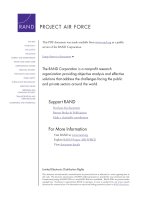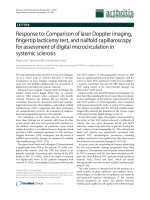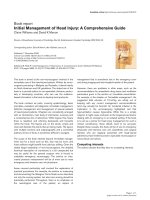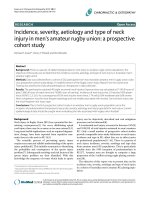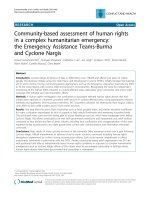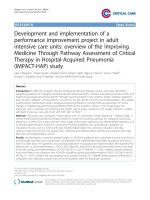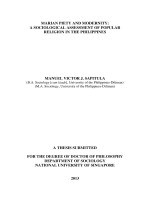ASSESSMENT OF MAGNITUDE AND OUTCOMES OF HEAD INJURY IN MYUNGSUNG CHRISTIAN MEDICAL CENTER (KOREA HOSPITAL), ADDIS ABABA, ETHIOPIA
Bạn đang xem bản rút gọn của tài liệu. Xem và tải ngay bản đầy đủ của tài liệu tại đây (502.59 KB, 40 trang )
ASSESSMENT OF MAGNITUDE AND OUTCOMES OF HEAD INJURY IN
MYUNGSUNG CHRISTIAN MEDICAL CENTER (KOREA HOSPITAL),
ADDIS ABABA, ETHIOPIA.
BY: ASFAWOSEN WOLDMESKEL (BSC)
A RESEARCH PROPOSAL SUBMITTED TO THE ADDIS ABABA
UNIVERSITY COLLEGE OF HEALTH SCIENCES, DEPARTMENT OF
EMERGENCY
MEDICINE
AND
CRITICAL
CARE,
IN
PARTIAL
FULFILMENT OF THE REQUIREMENTS FOR THE MASTERS DEGREE IN
EMERGENCY MEDICINE AND CRITICAL CARE NURSING.
JUNE, 2017
ADDIS ABABA, ETHIOPIA
ASSESSMENT OF MAGNITUDE AND OUTCOMES OF HEAD INJURY
IN MYUNGSUNG CHRISTIAN MEDICAL CENTER (KOREA
HOSPITAL), ADDIS ABABA, ETHIOPIA.
BY:
ASFAWOSEN WOLDMESKEL (BSC)
ADVISORS:
DR. TIGIST ZEWDU (MD, EMERGENCY PHYSICIAN, ASSISTANCE
PROFESSOR OF EMERGENCY MEDICINE)
MEBRAT MICHAEL ( AAUCHS, MSC,EMCCN LECTURER)
JUNE, 2017
ADDIS ABABA, ETHIOPIA
ABSTRACT
Background: Trauma, especially head trauma, is an expanding major public health problem and
the leading cause of death of the young and productive part of the world’s population.
Objective: To assess the magnitude and outcomes of head injury among patients presented to
adult emergency department of Myungsung Christian medical center, from January 01, 2016 to
January 01, 2017, Addis Ababa Ethiopia.
Methods: Institutional based retrospective, cross sectional study was conducted at Myungsung
Christian medical center, from January 01, 2016 to January 01, 2017, Addis Ababa Ethiopia.
All head injury patients who fulfills inclusion criteria and visited Myungsung Christian medical
center during the period from January 01, 2016 to January 01, 2017 were selected for the study.
Result. From total of 673 trauma patients visited adult emergency of MCM hospital from
January 12016 to January 1, 2017, there were 168 head injury patients and included in this
study of which 124 (73.8%) were males and 44(26.2%) were females. From the 168 head injury
patients, severity of head injury was categorized depending on GCS and 11(6.4%) severe, 73
(43.5%) moderate and 84(50%) were mild type of head injury. Road traffic accident was the
leading 59(43.3%) followed by fall down accident 49(35.8%) and assault or fighting measures
for 29(21.2%) of head injury patients. The majority of the patients 99(58.8%) were improved,
28(16.7%) cured, 7(4.2%) died and 34(20.2%) were with unknown outcome because they were
referred to other hospitals.
Conclusion: the analysis of this study revealed that road traffic accident is the major cause of
head injury and head injury patient with associated injury are more at risk to develop
complications than with no associative injury.
Key words: head injury, magnitude, outcomes, retrospective, Myungsung Christian medical
center.
i
ACKNOWLEDGMENT
I would like to express my gratitude to Addis Ababa University College of health science,
emergency medicine department for giving me chance to conduct this study.
Secondly, my deepest appreciation is to my advisors Dr. Tigist Zewdu and Sr. Mebrat Michael
(MSC) for their valuable comments and criticism from the beginning of my study thesis.
I am also thankful to my Families for their moral and material support. My gratitude also goes to
my friends for their direct or indirect contribution to the development of this study.
ii
TABLE OF CONTENTS
ABSTRACT..................................................................................................................................... i
ACKNOWLEDGMENT................................................................................................................. ii
LIST OF FIGURES ....................................................................................................................... vi
LISTS OF TABLES ...................................................................................................................... vii
LISTS OF ABBREVIATIONS /ACRONYMS ........................................................................... viii
1. INTRODUCTION ...................................................................................................................... 1
1.1 Background ........................................................................................................................... 1
1.2. Statement of the Problem ..................................................................................................... 2
2. LITERATURE REVIEW ........................................................................................................... 5
3. OBJECTIVES ........................................................................................................................... 10
General Objective ...................................................................................................................... 10
3.2 Specific Objectives .............................................................................................................. 10
4. RESEARCH METHODOLOGY.............................................................................................. 11
4.1 Study area and Period.......................................................................................................... 11
4.2 Study Design ....................................................................................................................... 11
4.3. Source Population .............................................................................................................. 11
4.3. Study population ................................................................................................................ 11
4.4. Inclusion and exclusion criteria.......................................................................................... 11
4.4.1. Inclusion criteria .......................................................................................................... 11
4.4.2 Exclusion criteria .......................................................................................................... 12
4.5. Sample size and sampling techniques ................................................................................ 12
4.6. Variables............................................................................................................................. 12
4.6.1 Dependent variables ..................................................................................................... 12
4.6.2 Independent variable..................................................................................................... 12
4.7. Data collection tools and procedures .............................................................................. 12
4.8. Data processing and Analysis ............................................................................................ 12
4.9. Data quality assurance ........................................................................................................ 13
4.10. Ethical consideration ........................................................................................................ 13
4.12. Dissemination plan ........................................................................................................... 13
4.11. Operational definitions and definition of terms ............................................................... 13
6. DISCUSSION ........................................................................................................................ 21
7. CONCLUSION AND RECOMMENDATION ........................................................................ 23
7.1 CONCLUSSION..................................................................................................................... 23
iii
7.2. RECOMMENDATIONS ....................................................................................................... 24
CHALLENGES AND LIMITATIONS OF THE STUDY. .......................................................... 25
8. REFERENCES ......................................................................................................................... 26
ANNEXS ...................................................................................................................................... 28
ANNEX 1. CHECK LIST/QUESTIONNAIRE ........................................................................... 28
ANNEX 2. Declaration ................................................................................................................. 30
iv
v
LIST OF FIGURES
Figure 1. Duration of hospital presentation after head injury at MCM from January 1, 2016 to
January 1, 2017. ............................................................................................................................ 15
Figure 2 severity of head injury admitted to MCM hospital from January 1, 2016 to January 1,
2017............................................................................................................................................... 16
Figure 3 the outcomes of head injury patients in MCM hospital, From January 1, 2016 to January
1, 2017........................................................................................................................................... 20
vi
LISTS OF TABLES
Table 1 gender of head injury patients at MCM hospital from January 1.2016 to January 1, 2017
....................................................................................................................................................... 14
Table 2. Age interval of head injury patients in MCM hospital from janury1, 2016 to January 1,
2017............................................................................................................................................... 14
Table 3 length of hospital stay of head injury patients at MCM from January 1, 2016 to January
1, 2017........................................................................................................................................... 16
Table 4 . Cross tabulation of mechanisms of head injury with their types (penetrate, blunt) at
MCM hospital from January 1, 2016 to January 1, 2017. ............................................................ 17
Table 5 Chi-Square Tests of mechanisms of head injury with identification ............................... 17
Table 6 associative injury of head injury patient in MCM hospital from January 1, 2016 to
January 1, 2017. ............................................................................................................................ 18
Table 7 . Complication of head injury in MCM hospital from January 1, 2016 to January 1, 2017.
....................................................................................................................................................... 19
vii
LISTS OF ABBREVIATIONS /ACRONYMS
ED - Emergency department
EM- Emergency medicine
GCS- Glasgow coma scale
JUTH- Jimma university teaching hospital
MCM- Myungsung Christian medical center
MD- Medical doctor
MTBI-Mild traumatic brain injury
RTA- Road traffic accident
SDH- Subdural hematoma
TBI-Traumatic brain injury
UK- United Kingdom
USA- United States of America
WHO- World health organization
viii
1. INTRODUCTION
1.1 Background
Head Injury has been defined as, “morbid state, resulting from gross or subtle structural changes
in the scalp, skull, and/ or the contents of the skull, produced by mechanical forces; trauma,
especially head trauma, is an expanding major public health problem and the leading cause of
death of the young and productive part of the world’s population. Depending on severity using
GCS, head injury classified into mild, moderate and severe. Research is mainly done in highincome countries where only a small proportion of the worldwide fatalities occur. (1)
Globally, head injury is a substantial cause of mortality and morbidity across all age groups, with
a disproportionately greater burden borne by low- and middle-income countries. In lessresourced settings, the burden of head injury is magnified by the high prevalence of risk factors
and by health systems which are often unable to effectively deliver the acute and long-term care
the patients require (2). A recent review of the global impact of traumatic brain injury (TBI)
identified that opportunities to adequately address this burden are compromised by limited
epidemiological data on the causes and characteristics of these injuries. This gap is particularly
apparent in Pacific Island countries and territories which are infrequently the focus of global
public health attention (4). A Centers for Disease Control and Prevention analysis of hospital,
emergency department (ED), and vital statistics databases estimated that about 1.4 million people
presented for medical care for a traumatic brain injury each year in the United States from 1995
through 2001. The analysis also found that approximately 50,000 (3.6%) of them died from their
injuries, 235,000 (17%) were hospitalized, and 1.1 million (80%) were treated and released from
the ED (5). Reviews of head injury epidemiology conclude that comparison of incidence rates
from different studies is difficult because of variations in definitions and inclusion criteria,
admission policies and health care systems within and between countries (6).
In a recent review by Tagliaferri et al., annual incidence rates of hospital admitted head injuries
varied between 91 and 546 per 100,000 populations per year in European countries (6).
1
1.2. Statement of the Problem
The World Health Organization (WHO) global burden of injury estimate ranks injury among the
top ten leading causes of death, with an estimated 5 million deaths annually of which men in
Africa have the highest injury-related mortality rates in the world. Among African nations the
rate of injury mortality in 2004 was the highest in Nigeria and the lowest in Egypt. South Africa
and Ethiopia were second and third, respectively (2).
The incidence of TBI worldwide is rising, mainly owing to injuries associated with the increased
use of motor vehicles, particularly in middle-income and low-income countries. Estimates of TBI
incidence show substantial variation between countries. Data from the CDC indicate that each
year in the USA, 1.7 million people sustain a TBI. A 1.4 million of these injured individuals are
treated in emergency departments, with around 275,000 hospitalizations and 52,000 fatalities. A
meta-analysis of reports from 23 European countries revealed a hospital admission incidence of
235 per 100,000 people (5). The annual incidence of traumatic brain injury in different African
countries ranges from 150-500/100,000 per year depending on the individual country. It is
estimated that 1-2% of high income populations live with a TBI disability and the incidence is
high in some countries in Africa. In South Africa, the mortality rate of TBI was reported to be
81/100,000 per year; with greater than 10% of all case fatality rate. High risk groups for TBI
include adolescents, young adults and the elderly, with males being affected 2-3 times more
often than females. The study also showed that the main causes and risk factors for head injury in
Africa are road traffic accident (RTA), falls and violence (4).
In Ethiopia, a prospective study which was conducted at JUTH on 52 head injury patients
indicated that the main risk factors are interpersonal fight 20 (38.5%) followed by RTA 19
(36.5%) and of all injuries 8 (15.4%) were due to falling accidents. According to this study, the
most affected age groups are < 15 years 17 (33%), 15- 24 years 17 (33%), 25- 34 years 9 (17%),
35- 44 years 4 (9%) and greater than 45 years accounts 5 (10%) (8).
In Ethiopia, even though there was no enough research conducted on head injury in the country’s
context, the prevalence of head injury is a common health problem that causes morbidity and
mortality in the productive age group of population which directly affects the development of the
country. Study which was conducted in Ethiopia at JUTH in 2010 indicated that head injury is
common public health problem of all traumas. So, since the problem affects the productive age
group of the country, I am interested to carry out my study on this topic which assesses the
magnitude and outcome of head injury.
1.3. Significance of the study
The study would add knowledge on understanding the magnitude and outcome burden of head
injury accidents in the country at large which helps concerned body for planning how to prevent
the occurrence of the incident. In addition, the study would provide base line information on
magnitude and associated outcomes of head injury cases. The result of this study will be used by
concerned bodies for planning and evaluating how to prevent the head injury. The
recommendation of this study could benefit the public at large in preventing head injury
accidents if due to consideration is given.
2. LITERATURE REVIEW
Traumatic brain injury (TBI) is an important global public health problem as a major cause of
traumatic death and disability. The spectrum of severity of TBI varies, but most TBI is classified
as mild traumatic brain injury (MTBI) followed by moderate and severe head injury, based on
clinical and surveillance definitions. From a public health perspective, it is important to know the
incidence of a condition in order appropriately to plan healthcare policy and provision.
Furthermore, determining what factors increase the risk of MTBI is necessary to develop public
health programs to prevent the problem and lessen the likelihood of disability (11).
According to a study which was conducted in Korea, a total of 349621 people were injured per
year in which 9057 people died within 72 hrs after accident and the mortality rate due to MVA is
28 per 100,000 people and from total injury, 68414 victims were head injuries. The mortality rate
of the head injury was 9.5% and the total number of death due to head injury was calculated to
be 8976 per year and the annual death rate due to head injury was to be 19 per 100,000
populations. According to this study, skull fracture was found in 43% in which operative
intervention was required in 28% and the operative mortality rate was 6%. The severity of head
injury based on GCS was mild in 73.4%, moderate in 11.4%, and severe in 16.3% (13)
According to study which was conducted in Norway, of 585 head injury patients which were
included in the study after evaluation in emergency room, 446(76%) were admitted for
hospitalization giving an admission rate of 157 per 100,000 population. This study classifies the
distribution of head injury based on GCS and presence or absence of consciousness at time of
examination to 492 (84%) mild, 16 (3%) moderate and 77 (13%) severe head injury. Sex specific
incidence rates were 258 per 100,000 for males and 156 per 100,000 for females and high age
specific incidence rates for men were found in the age group 10-24 years with the peak (428 per
100,000 among teenagers between 15- 19 years). According to this study the causes of head
injury were falls in 299 (51%), RTA in 126 (21%), assaults in 81(14%) and other in 79 (14%)
cases and male to female ratio was highest for head injury caused by assaults (2.9:1) and lowest
for by RTA (1.4:1) (6). A Study which was conducted on hospitalized and fatal head injuries in
VitiLevu, Fiji, during the 12-month injury surveillance period indicated that Out of 2,233
individuals admitted to hospital as a result of injury, 276 cases (12.4%) had a primary diagnosis
of head injury.
The overall rate of head injuries was 42.4/100,000 and over three quarters of cases were male
and the age- standardized rate for males for all head injuries (60.5/100,000 (95% CI 52.1, 68.8))
was more than three times of the female rate (18.4/100,000 (95% CI 13.7, 23.1); p! 0.001). Head
injuries are most commonly occurred among those aged 15–29 years, followed by children aged
0–14 years and least common among older adults (45 years and older). Of the three leading
causes of injury, road traffic crashes had the highest rate of head injury (16.1/100,000 (95% CI
13.1, 19.2)), followed by falls (12.0/100,000 (95% CI 9.3, 14.6)) and „hit by person or object‟
(10.6/100,000 (95% CI 8.1, 13.1)) (4).
A prospective study which was conducted at Tertiary Care Hospital in India during period
between 2011- 2013 on 500 head injury patients indicated that the majority of head injuries are
due to Road Traffic Accident 298 (59.60%) cases followed by fall from Height 101 (20.20%)
cases, Assault 21 (4.20%) and occupational head injury 79 (15.80%) cases, whereas other like
gunshot comprised of 1 (0.20%) cases.
The peak incidence of head injury was observed in the age group 21-30 years comprising 45% of
the cases and it was also observed that 21% belonged to the age group 31-40 years.
Out of 500 cases 383 (76.6%) were males while 117 (23.4%) were females, thus a male to
female ratio of 3.27:1 was observed and head injury commonest lesion was Scalp laceration
which accounts 251 (50.2%) cases, followed by fractures of skull 83 (16.6%) cases, contusion 53
(10.6%) which is commonest in intra-cranial lesions. SDH 61 (12.2%) was commonest intracranial hemorrhage followed by SAH 52 (10.4%) cases. This study also showed that most
commonly involved skull fracture in head injury cases were temporal bone 22 cases (26.51%)
followed by frontal bone which was 21 cases (25.30%), multiple bone 24 cases (28.92%),
parietal bone 12 cases (14.46%) and occipital bone 4 cases (4.82%) (14).
According to another study which was conducted in India on 2850 head injury in which age of
the victims varied from 15 – 80 years indicated that the peak incidence was observed in the age
group 15 - 24 years comprising 34.46 % of the cases, 22.15 % belonged to the age group 25- 34
years, 56.61 % of cases comprised of age group of 15 - 34 years. Individuals in the age group 65
years and above were the least affected that is 4.21 % of total cases. Out of total cases 2442
(85.68%) were males while 408 (14.31%) were females which shows a male to female ratio of
6:1 and the majority of victims are of road traffic accident 1568 (55.02%) cases followed by
assault 646 (22.67%) cases. Fall from height 361 (12.67%) and gunshot were 245 (8.59%) cases,
whereas occupational comprised of 30 (1.05%) cases. Skull fracture was seen in 969 (34.0%)
individuals out of total 2850 cases and among the intracranial injuries, epidural hemorrhage was
the commonest, present in 495 (17.36%) cases and subdural hemorrhage present in 217 (7.6%)
cases, followed by subarachnoid hemorrhage in 102 (3.50%) cases and Contusions of the brain
parenchyma were present in 325 (11.4%) cases (16). A Study which was conducted in Egypt at
Assiut University indicated that, total number of head injured cases were 1331 out of 43,310
total number of trauma patients with an incidence of 3.07%. Head injuries due to road traffic
accidents represents 60.9% (810 cases) and 35.8% of cases (290) were in age group between 2030 years, followed by the age group between 10-20 (22.2%) and 30- 40 (18.52%), the least
affected age group was age greater than 60 (4.9%) and less than 10 ( 2.5%). Males affected more
than females which accounts 85.7% of males and 14.3% of females with a ratio of 6:1 (17).
In 1100 (83%) patients out of 1331, head injury was associated with major bone fracture in other
body regions and 231 (17%) were pure head injuries. 182 (79%) of patients with pure head
injuries were due to road traffic accidents, 43 (24%) of them had lacerated wounds in the scalp
and the radiological examination revealed nothing. The remaining patients 139 (64%), the
radiological findings varied from skull fracture (36.7%), brain contusion (28.7%), and hematoma
(23%) and diffuse brain injury (33.1%). Patients with radiological findings (139) were classified
according to Glasgow Coma Scale (GCS) into: severe (GCS < 8) which accounts (32%),
moderate (GCS 9-12) accounts 22% and mild (GCS 13-15) accounts 46%. Complete recovery
occurred in 93.7% of cases with GCS 13-15 while recovery was not recorded among patients
with GCS < 8. Death occurred in 66.6% of patients with GCS < 8 and 3.3% in GCS 9-12 (17).
According to a study conducted in Nigeria, A total of 3282 patients were admitted during the
study period of whom 428 (13.0%) had head injuries. There were 342 (79.9%) males and 86
(20.1%) females with males to females ratio of 3.9:1 and incidence was common in age between
21- 30 years (n=145, 33.8%), while the least were those between 71-80 years (n=3, 0.7%). Road
traffic accidents (RTAs) were the most common cause of injury accounting for 307 (71.7%)
patient. 244 (57.0%) had associated injuries along with head injury of which fractures were the
majority (n=93, 21.7%) and with skull fracture being the most common (n=27, 26.5%).
Lacerations, abrasions and other blunt injuries also made up a significant portion of injuries
(n=52, 12.1%), followed by intracerebral/ subdural hemorrhages (n=13, 3.0%) (18). According
to this study, severity of head injury on Glasgow coma scale indicated that majority of patients
suffered mild head injury (277, 64.7%), 58 (13.6%) suffered moderate head injury, while 93
(21.7%) sustained severe head injury. A total of 194 (45.3%) patients presented with history of
loss of consciousness (LOC) with duration of less than 1 hour in 46 (23.6%) patients, 1 hour to
24 hours in 62 (31.8%) patients and greater than 24 hours in 87 (44.6%) (17).
According to the study which was conducted at JUSH which is Four (4) month Prospective
study, on 52 head injury patients indicated, female to male ratio was 1:9 and Interpersonal fight
(n=20, 38.5%) and traffic Accidents (n=19, 36.5%) accounted for most of the injuries.
Of all injuries, 15.4% (n=8) were due to falling accidents mainly in children and distribution of
the severity of injury measured with the initial Glasgow Coma Score (GCS) indicates that 37
(71%) of all patients were discharged with a good recovery Glasgow Outcome Scale (GOS) 5,
7.7% .(18)
with a disability and 21.2% died and All patients with initial GCS greater than 6 survived
whereas almost all patients with initial GCS 6 and less were died and Patients with both nonreactive pupils at the initial examination died in 87.5% of cases (19). This study also showed
patients who sustained injury from fight or fall were more likely to have an outcome with good
recovery (GOS 5) compared to patients with road traffic injury (RTI) or other causes. Only 10%
of the patients who sustained injury from interpersonal fight had an initial GCS below 9
compared to 52.6% in RTI patients. In this study, 40 (77%) of all patients were managed
conservatively. Twenty-seven (27) patients had a skull x-ray which showed a fracture in 15 cases
and nineteen (19) patients had no skull x-ray done. Median initial GCS of the patients that had
visible skull fractures on the x-rays was 13 and patients who underwent no skull x-ray had a
median initial GCS of 10 (20).
3. OBJECTIVES
General Objective
To assess the magnitude and outcomes of head injury presented to adult ED of
Myungsung Christian medical center (Korea hospital,) from January 01, 2016 to January
01, 2017, Addis Ababa, Ethiopia.
3.2 Specific Objectives
To determine the magnitude of head injury among patients presented to adult ED of
Myungsung Christian medical center.
To identify mechanism of injury associated with head injury among patients
presented to adult ED of Myungsung Christian medical center.
To assess the outcomes of head injury among patients presented to adult ED of
Myungsung Christian medical center.
4. RESEARCH METHODOLOGY
4.1 Study area and Period
Myungsung Christian medical center (MCM) is located in the southeastern part of Addis Ababa,
the capital city of Ethiopia. MCM compound is consisted of two wings; shalom wing with the
capacity of 161 bed facility;(40)surgical,(25)medical,(20) pediatrics, seven OBGs, ten ER and
(11) intensive care and grace wing with the capacity of 67 beds, as well as a separate medical
college with a 6 year curriculum including internship. MCM offers ophthalmologic, dental,
plastic surgery, ENT, psychiatry and hemodialysis services as part of community health
programs, in addition to general medicine, pediatrics and obstetrics& gynecology. Long term
expatriate staff includes one American family medicine doctor, 4 Korean-American physicians
(general surgeon, anesthesiology, radiology and pathology), one Norwegian plastic surgeon, and
one Korean dentist.
The study period was from December to June, 2017.
4.2 Study Design
Institutional based retrospective, cross sectional study was conducted to asses magnitude and
outcomes of head injury patients presented to MCM from January 01, 2016 to January 01.2017.
4.3. Source Population
All patients presented to adult ED of Myungsung Christian medical center (Korea hospital,) were
the source population for the study,
4.3. Study population
All head injury patients presented to adult ED of Myungsung Christian medical center (Korea
hospital,) from January 01, 2016 to January 01, 2017
4.4. Inclusion and exclusion criteria
4.4.1. Inclusion criteria
All selected head injury records of patients visited adult ED of Myungsung Christian medical
center (Korea hospital,) from January 01, 2016 to January 01, 2017, whose age is above 13 years
were included in the study.
4.4.2 Exclusion criteria
Head injury Patients chart that has inadequate data (greater than 20% incomplete) were
excluded.
Head injury patient’s charts which are lost from record office due to consultation, transfer
or any other medical reason at the time of data collection were excluded.
Head injury patients who are died at arrival were excluded.
4.5. Sample size and sampling techniques
All head injury patient who fulfills inclusion criteria and visited Myungsung Christian medical
center (Korea hospital) during the period under study were included in the study as sample size
and convenient sampling technique was employed.
4.6. Variables
4.6.1 Dependent variables
magnitude of head injury
Outcomes of the head injury
4.6.2 Independent variable
Age
Sex
Mechanism of head injury
4.7. Data collection tools and procedures
For data collection, check lists which was developed after review of similar literatures was used
and data were recorded on structured check lists through reviewing of patient chart
retrospectively. Three BSc nurses were recruited for data collection after they have given one
day training on data collection tools and techniques.
4.8. Data processing and Analysis
After the collected data checked for completeness and consistency, data were encoded and
entered to SPSS Version 21.0. After entering, data were cleaned, arranged, and analyzed using
descriptive statistics. Results were showed using frequency tables, bar graphs, pie chart and cross
tabulation.
4.9. Data quality assurance
Pretest was done on 5% of study sample patient chart at study setting who excluded from final
study to check the validity and reliability of data collection tools and necessary modifications
was made based on the findings. Prior to data collection period, one day training was given for
data collectors. Onsite supervision was given to solve any ambiguity with data collection tools
and techniques and the filled check lists were cross checked at the end of each data collection
day for completeness and consistency.
4.10. Ethical consideration
The proposal was presented to Addis Ababa University, Emergency department and ethical
clearance was obtained from Addis Ababa University, College of health sciences and IRB. In
order to obtain permission to proceed with data collection, the official letter was written to MCM
administrations. During patient chart review confidentiality was kept and any patient information
was not transferred to any other organ.
4.12. Dissemination plan
The result of this study was given to the study setting and to Addis Ababa University, College of
health science, department of Emergency medicine, and the finding would be disseminated to
concerned bodies such as service providers, policy makers and other concerned stake holders.
Finally, this paper would be published through relevant journals.
4.11. Operational definitions and definition of terms
Prevalence- the total number of cases of a disease in the given statistical population at a given
time.
Head injury- physical damage/ structural change to the scalp or skull due to any type of external
force to the head.
Traumatic brain injury (TBI) - alteration in brain function which is manifest as confusion,
altered level of consciousness, coma, seizure, and etc.
GCS- Glasgow coma scale used for assessing the neurological status of the patient.
Trauma- any serious injury to the body often resulting from violence or an accident.
Mild head injury- an injury to the head when Glasgow coma scale is between 13 and 15.
Moderate head injury- an injury to the head when Glasgow coma scales between 9 and 13.
Severe head injury- an injury to the head when Glasgow coma scale is less than or equal to 8.
5. RESULT
5.1 Socio-demographic data:
This retrospective institutional based study was done at Myungsung Christian medical center
(Korean hospital) which is found in Addis Ababa and located around the place called Gerji.
From total of 673 trauma patients visited adult emergency of MCM hospital from January 1,
2016 to January 1, 2017, there were around 200 head injury patients and 168 head injury
patients included in this study. The remains are excluded by the study exclusion criteria.
Among these 168 head injury patients, 124 (73.8%) were males and 44(26.2%) were females.
Table 1 gender of head injury patients at MCM hospital from January 1.2016 to January 1,
2017
Frequency
male
female
Total
Percent
124
73.8
44
26.2
168
100.0
The majority of head injury patients 77(45.8%) found in age interval of 13-30years, 56(33.3%)
in 31-45years and 35(20.8%) above 45 years old.
Table 2. Age interval of head injury patients in MCM hospital from janury1, 2016 to
January 1, 2017.
Age interval of head injury patients
Frequency
Percent
13-30 years old
77
45.8
31- 45 years old
56
33.3
above 45
35
20.8
168
100.0
Total
Regarding time of hospital presentation after head injury the majority of patients 145(86.3%)
presents within the first 1-6 hours duration, 17(10.1%) within 7-12 hours and 6(3.6%) of head
injury patients within 13 -24 hours duration.
86.3%
160
140
120
100
80
60
40
10.1%
20
3.6%
0
1-6hours
7-12hours
13-24hours
Figure 1. Duration of hospital presentation after head injury at MCM from January 1,
2016 to January 1, 2017.

